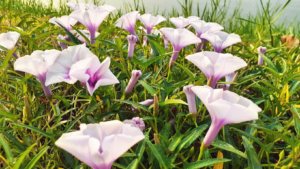Weed Control in My Yard
After years of finding the perfect home, you just want...
Posted on January 4, 2024 by Lawn Doctor
Morning Glory is an annual flowering vine plant that’s fast-growing and can easily climb up trellises and other structures. It can make a beautiful addition to a garden, depending on who you ask. Many consider common morning glory flowers desirable plants, but having them in the garden can be challenging for a variety of reasons. Some prefer to get rid of them altogether to prevent any potential issues.
Common morning glory (Ipomoea purpurea) is a plant with flowers that come in a range of different hues. Its flowers open in the morning and shrivel by evening from summer into fall. Its vines can grow as much as approximately 10 feet wide in a season and upward of 8 feet in height.
It’s easily identifiable by its trumpet-shaped blooms that come in shades such as blue, pink, white and purple, and its green leaves are heart-shaped. The seed pods look similar to an acorn without the “hat,” with each pod typically containing multiple black triangle-shaped seeds.

Both common morning glory and field bindweed are part of the Convolvulaceae family. It’s easy to confuse the two, made even more difficult by how field bindweed is often referred to as morning glory or morning glory weed. Field bindweed, a perennial invasive weed, also has trumpet-shaped flowers that are typically pink or white and smaller than common morning glory flowers.
Its deep roots, which can grow up to several feet, can make it difficult to remove and kill, whether you’re trying to pull out the roots or kill the weeds with herbicides. It’s also drought tolerant and can easily overtake greenery, such as vegetables and flowers, that you want in your garden and undisturbed.
There are typically a few ways to differentiate between the two, with the most obvious being its leaves. While morning glory has heart-shaped leaves, field bindweed (Convolvulus arvensis) has arrowhead-shaped leaves that are narrower than the ones on the flowering plant.
Although Ipomoea purpurea is one type of species of morning glory under the Ipomoea genus, there are hundreds of other species. Many people are likely also familiar with the Ipomoea nil species. Grandpa Ott (Ipomoea nil), Scarlett O’Hara (Ipomoea nil), Crimson Rambler (Ipomoea purpurea) and Kniola’s Black (Ipomoea purpurea) are some gorgeous types you may recognize.
Common morning glory weeds can strangle other plants if they’re not contained, and they can grow rapidly over a wide area. Another issue is that they reseed themselves every year and have poisonous seeds, but the actual flowers aren’t poisonous. This can cause problems for curious kids, especially if the children manage to eat a large amount of the small triangle-shaped seeds. Some animals, like birds and butterflies, adore the flowers, but the seeds are also toxic to pets, including cats, horses, and dogs. Hallucinations are one of the symptoms of toxicity.
The possible toxicity can be especially worrisome for homeowners who have pets that freely roam the property. Removing the morning glory can help eliminate the temptation, particularly before the plants continue to grow quickly and develop more seed pods.
The best thing you can do is attempt to pull common morning glory up from the roots, but the good news is that its roots aren’t as difficult to remove as the ones on field bindweed. One of the biggest issues with trying to kill common morning glory is that it continuously reseeds itself as the seed pods fall to the ground and split open, so it’s vital to pick up any seed pods and seeds that land on the ground in the process or that have already fallen to the ground. Try not to leave any behind. Considering the small size of the seeds and their coloring, this can prove incredibly challenging.
Once you pull up morning glory from the roots and you’ve collected the seeds and seed pods, don’t simply toss them in another part of the yard or off to the side somewhere, even temporarily. They need to immediately go into a heavy-duty garbage bag that won’t accidentally rip and inadvertently spread tiny dark seeds all over your yard as you’re taking it out to the garbage can.
If you want to prevent morning glory from growing (or re-growing), you have to catch it when it first sprouts or — at the very least — as soon as you notice it, regardless of its height and how far it has already grown. Considering how fast it can grow, it’s not a task you want to put off. If it’s already gotten to the point where there are seed pods, make sure none fall to the ground as you’re pulling out the plants. Additional control methods, such as using landscape fabric or a thick layer of mulch, may also help, depending on the situation.
Simply chopping down the common morning glory or snipping it at the soil line won’t work. Dig out the roots as much as you can. However, know that this probably isn’t a one-and-done process. You’ll likely have to continue the task repeatedly for an indefinite amount of time, even if it seems like you got it all the first time around.
When it comes to dealing with morning glory or — even worse — field bindweed, know that you’re not alone. We have extensive experience managing and removing both, so we can come up with a plan that can assist with your particular situation. Call Lawn Doctor as soon as you notice the sprouting issue so we can start the process of preventing it from spreading, especially if you have fruits, vegetables, and other flowers nearby you want to help protect.
Contact Lawn Doctor to help care for your lawn when you can’t.